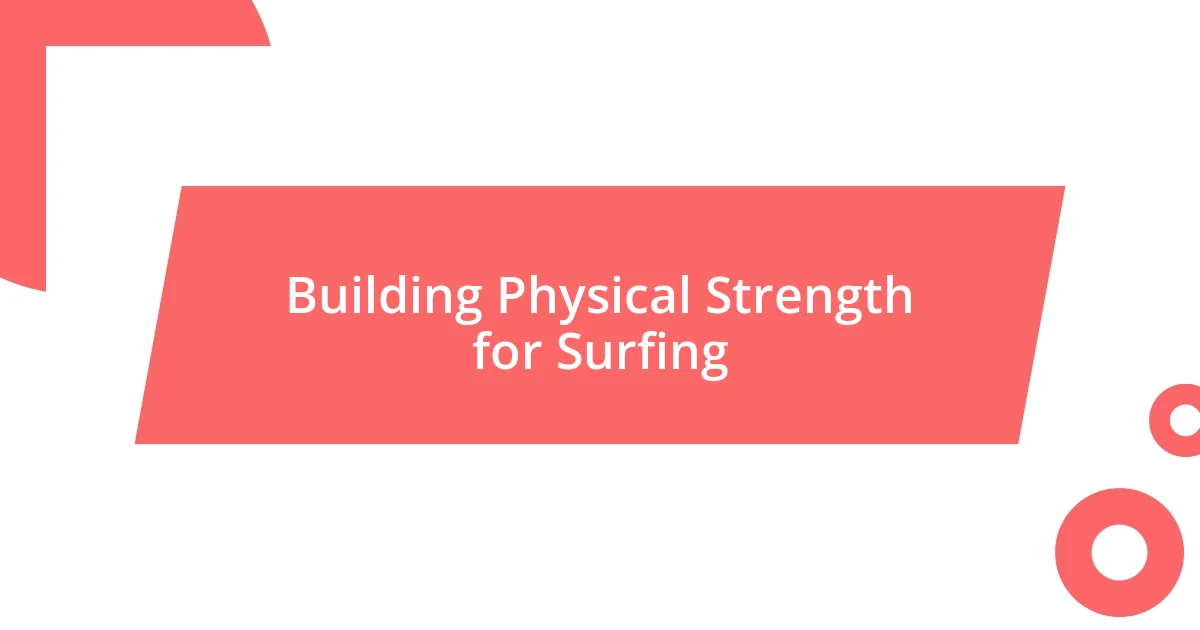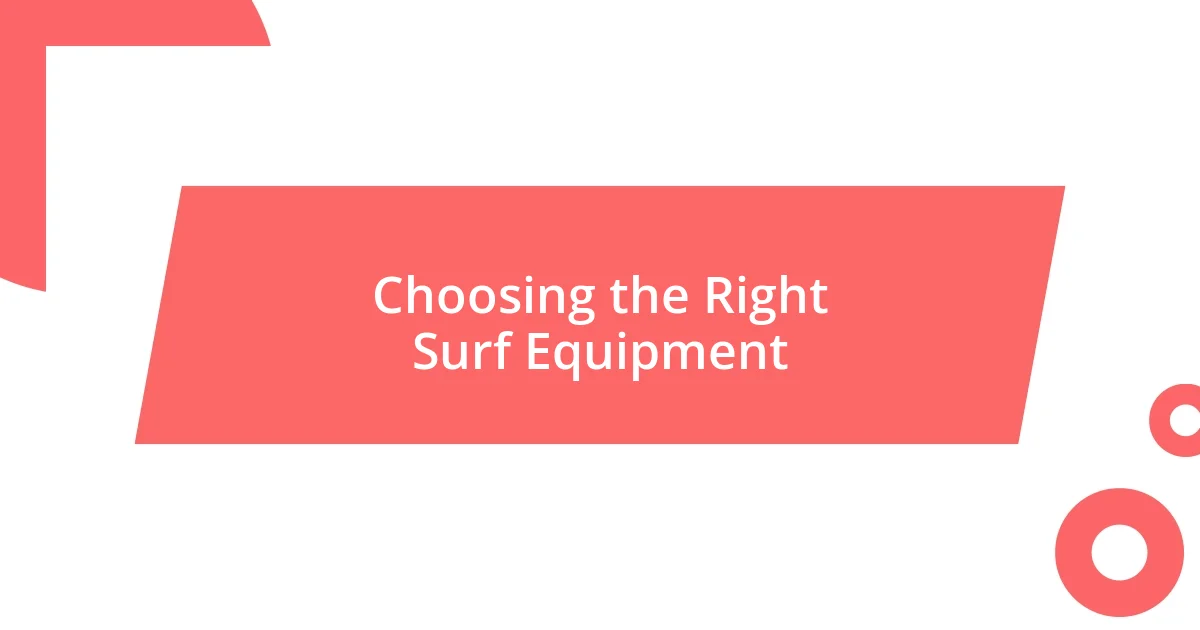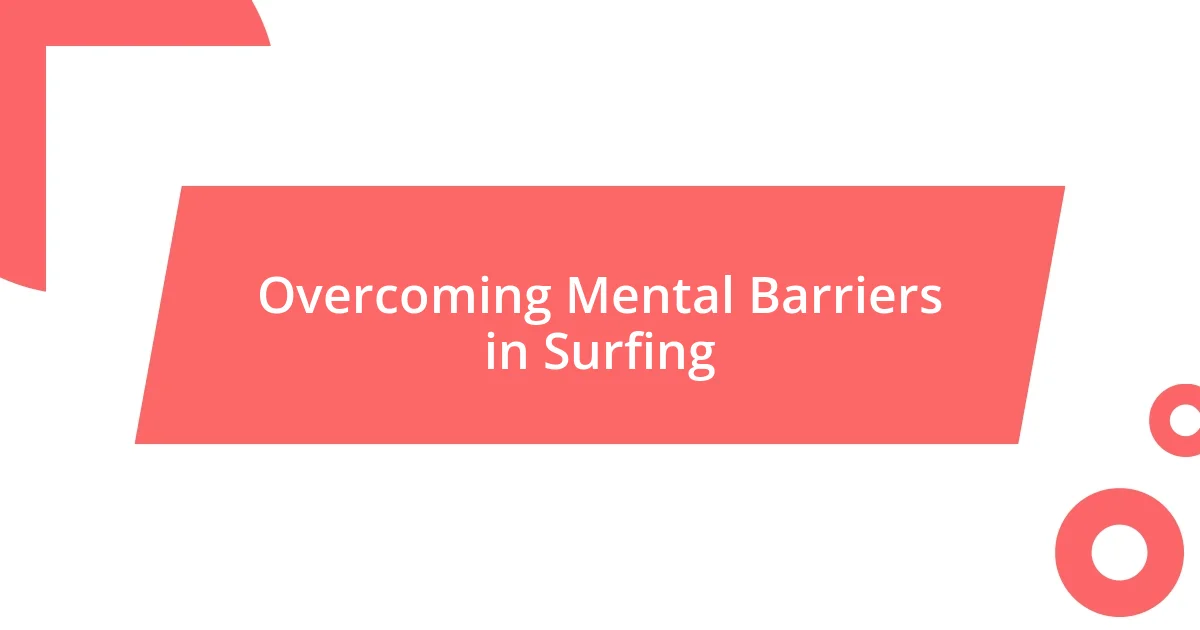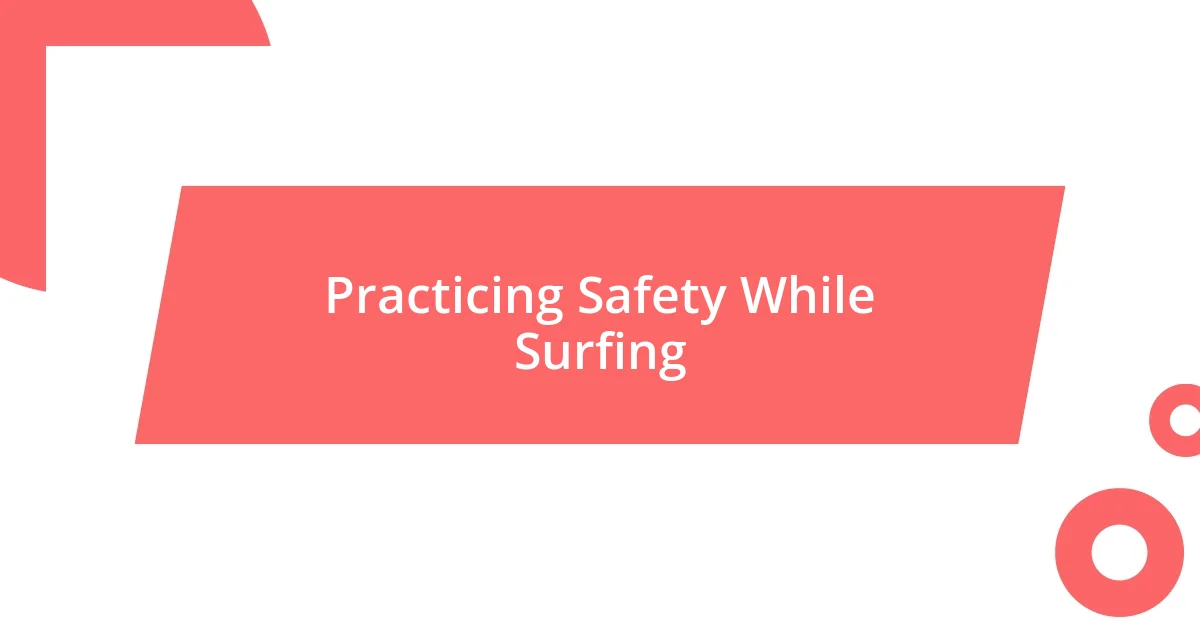Key takeaways:
- Understanding and aligning personal goals enhances the surfing experience and fosters a deeper connection with the ocean.
- Building physical strength through targeted exercises is essential for improving performance and maneuverability in surfing.
- Tracking progress through journaling and video analysis is vital for recognizing growth and setting achievable goals.

Understanding Your Surfing Goals
Understanding what you truly want from your surfing experience is vital. I remember when I first started, my only goal was to catch as many waves as possible. But over time, I realized that my aspirations shifted; I wanted to master certain techniques and share those exhilarating moments with friends. Isn’t it amazing how our motivations evolve?
Setting goals that resonate with you personally can transform your entire approach to surfing. Have you ever felt that rush when you finally ride a wave you’ve been eyeing? That’s what happens when you align your goals with your passions. I once set a goal to surf a specific beach each month, which not only improved my skills but deepened my connection to the ocean itself.
Reflecting on your journey is a crucial part of understanding your goals. I often ask myself, “What do I want to achieve this session?” Whether it’s improving my take-off or simply enjoying the moment, acknowledging these desires fuels my progress. What about you? What drives you to paddle out each day?

Building Physical Strength for Surfing
Building physical strength is a game-changer in surfing. I remember the first time I tried to pop up on my board after a long paddle. I struggled to find my balance, partly because my upper body strength wasn’t up to par. Focusing on strength training has made a significant difference in my performance. It enhances not only my paddling but also my ability to navigate waves once I’m riding them.
To effectively build strength for surfing, I encourage incorporating a variety of exercises into your routine. Here are some activities that I’ve found beneficial:
- Push-ups: Great for building upper body strength for paddling.
- Planks: Essential for core stability, crucial in maintaining balance.
- Squats: Help strengthen your legs, improving your maneuverability on the board.
- Resistance band exercises: Target the shoulders and back, simulating the paddling motion.
- Yoga: Enhances flexibility and helps with the mental focus needed in surfing.
By mixing these workouts into my schedule, I’ve seen a noticeable improvement in my energy levels and technique. Each small gain feels like a victory in my surfing journey. How do you feel about your physical preparation?

Improving Your Surfing Technique
Improving your surfing technique is a continuous journey, and I often find that focusing on the fundamentals pays off immensely. When I first started to seriously analyze my stance and balance, it felt a bit awkward. However, I learned that small adjustments can lead to huge breakthroughs. For example, shifting my weight ever so slightly on my back foot allowed me to turn much more fluidly. Have you ever noticed how a tiny change can transform a ride?
Another critical aspect is practicing your paddling technique. I vividly remember the thrill of catching my first big wave, but I had to work on paddling effectively to get there. I now make a point of practicing my paddling rhythm between sets, ensuring I maximize every stroke. It’s not just about strength; it’s about efficiency and timing. Each time I hit the water, I mentally review my technique, which keeps my mind focused and my body ready. How do you approach your paddling technique?
I also emphasize the importance of watching and learning from others. I can recall a time when I was mesmerized by a more experienced surfer effortlessly gliding through the waves. Instead of feeling discouraged, I used that moment as inspiration. I dissected what made their technique so appealing and adapted it to my style. Surrounding myself with skilled surfers has helped me grow tremendously. So, where do you seek inspiration for your surfing technique?
| Technique | Description |
|---|---|
| Stance | Adjusting weight on the board improves balance and maneuverability. |
| Paddling | Practicing a rhythmic and efficient stroke aids in wave-catching ability. |
| Observation | Learning from more experienced surfers inspires personal growth. |

Choosing the Right Surf Equipment
Choosing the right surf equipment is crucial for pushing your limits in the water. When I first started, I remember the sinking feeling of realizing my board was too big for my skill level. I was struggling to control it, and it had a huge impact on my confidence. After switching to a smaller, more maneuverable board, I felt a renewed sense of freedom as I caught waves with noticeably more control. Have you ever experienced the difference between using equipment that suits you versus something that doesn’t?
The importance of a good wetsuit can’t be overstated either. I had my fair share of cold, uncomfortable sessions that left me shivering and frustrated. I invested in a high-quality wetsuit that provided warmth without sacrificing flexibility. Now, I can focus on my ride rather than constantly battling the chill. What about your wetsuit? Does it empower or hinder your surfing experience?
In addition to boards and wetsuits, don’t overlook the finer details like fins and leashes. I once lost a wave because my leash snapped at the worst moment, and I was left scrambling to retrieve my board. Once I prioritized reliable gear, I felt a sense of safety and confidence that allowed me to push my limits further. Have you revisited your gear choices lately? Sometimes, those small updates can lead to substantial gains on the water.

Overcoming Mental Barriers in Surfing
Building a resilient mindset is essential for tackling those nagging mental barriers in surfing. I’ve experienced days where the fear of a big wave felt paralyzing. I still remember standing on the shore, watching others effortlessly catch waves while I hesitated. It was in that moment I decided to challenge myself: I took a deep breath and pushed through the anxious thoughts. By consistently exposing myself to bigger waves, I gradually transformed that fear into excitement. Have you ever found that facing your fears on the water helps reshape your confidence?
Visualization is another powerful tool I utilize. Before hitting the water, I spend a few minutes mentally rehearsing my rides. I imagine every turn, the feeling of the board under my feet, and the thrill of the wave. I can’t tell you how many times this practice has allowed me to surf with clarity and purpose. By creating a mental image, I set a positive tone before even stepping foot in the ocean. Have you practiced visualization? It could be the key to unlocking your potential.
Building a supportive community has also been a game changer for me. I remember my first surf trip with a group of friends; we challenged each other to try new tricks and tackle tougher waves. It was this camaraderie that helped me break through my mental barriers. Hearing encouragement from friends when I was afraid or uncertain made all the difference. Surrounding myself with like-minded surfers inspires me to push beyond my comfort zone regularly. Who lifts you up in your surf journey?

Practicing Safety While Surfing
Practicing safety while surfing is a non-negotiable aspect of enjoying the sport. I vividly remember one session when I forgot to check the surf conditions. The waves were much larger than I anticipated, and I found myself battling the ocean’s force more than I’d expected. I learned that taking a moment to evaluate the conditions can be the difference between a fantastic session and one filled with anxiety. Have you ever ignored safety warnings only to regret it later?
Wearing a leash is something I consider a basic rule. I recall a day when I wiped out spectacularly, my board somehow getting launched far away. Without a leash, it would have taken ages to retrieve it, and worse, I could’ve hurt someone else. Now, the thought of hitting the water without my leash feels utterly reckless. It’s all about that added layer of safety that allows me to focus solely on my ride. What habits do you have to ensure you stay safe while pushing your limits?
I also find that surfing with a buddy is one of the best safety nets you can have. If anything goes sideways, there’s someone there to watch your back, ready to help. I once got caught in a rip current, and my friend was right beside me, ready to guide me back to safety. That feeling of having support truly reassured me. How often do you hit the waves alone versus with friends? It’s something worth considering, especially if you enjoy challenging yourself in bigger surf.

Tracking Your Progress and Growth
Tracking your progress in surfing is like mapping out a personal journey on the water. I remember when I first started taking notes after every session. I’d jot down my biggest waves, the tricks I attempted, and how I felt during each ride. Looking back at those notes helped me see how much I’d grown, both in skill and confidence. Have you ever considered keeping a surf journal? It could reveal patterns in your performance that you might not notice otherwise.
Using video can also be a game-changer in tracking growth. I started filming my sessions, even when I felt hesitant about being in front of the camera. Watching my rides afterward illuminated areas where I could improve, like my pop-up technique or balance. It was humbling to see my progress laid out visually. There’s something incredibly motivating about seeing your past self evolve on the screen. How do you assess your own performance? Sometimes, a fresh perspective is all you need.
Lastly, setting specific goals has been crucial for my progression. I recall aiming to conquer a particular maneuver that initially seemed out of reach. I broke it down into smaller, achievable steps and celebrated each milestone. When I finally nailed that maneuver, the sense of accomplishment was indescribable. Establishing clear, incremental goals not only tracks your progress but also fuels your passion for surfing. What goals are you setting for yourself? Each small win counts on the road to greater achievements.















